There are several types of bathtubs depending on where/how they are installed, how they are made, the material they are made from, size and shape. Choosing one for your bathroom is always not an easy task.
A bathtub is an expensive item and you should therefore take your time to study the different types on offer, their pros and cons, so that you end up buying the best one. There are so many factors you need to analyze before choosing a specific one as I will outline in this post.
There are 10 types of bathtubs. These are:
- Alcove bathtubs
- Freestanding bathtubs
- Clawfoot bathtubs
- Whirlpool/Jetted bathtubs
- Soaking/Japanese bathtubs
- Drop-in bathtubs
- Walk-in bathtubs
- Corner bathtubs
- Undermount bathtubs
- Hot tubs
Here is a simple comparison of different typs of bathtubs:
| Aspect | Freestanding | Alcove | Drop-In | Corner | Walk-In | Whirlpool | Soaking |
|---|---|---|---|---|---|---|---|
| Aesthetics | Elegant and luxurious | Sleek and space-efficient | Can be customized | Fits into corners | Accessible and user-friendly | May have built-in jets | Clean, minimalist design |
| Materials | Various options (e.g., cast iron, acrylic, copper) | Typically made of acrylic, fiberglass, or enameled steel | Variety of materials, including acrylic and cast iron | Acrylic, fiberglass, or cast iron | Acrylic or fiberglass | Acrylic or fiberglass with jets | Acrylic or fiberglass |
| Installation | Freestanding, requires floor support | Fits between walls, easy to install | Requires a deck or platform | Fits into corners, custom installation | Walk-in design, requires bathroom space | Drop-in style, requires platform | Drop-in or freestanding |
| Size | Various sizes available | Standard sizes | Customizable | Space-efficient | Compact size | Various sizes | Various sizes |
| Accessibility | Typically easy to enter and exit | Standard accessibility | Step-over required | May have low step-in or built-in seat | Designed for easy entry and exit | Not designed for mobility challenges | Standard accessibility |
| Jet System | Optional whirlpool jets | Some models may have jets | Can be equipped with whirlpool jets | Limited to some models | Not typically equipped with jets | Equipped with water and air jets | No jets |
| Maintenance | Easy access for cleaning and maintenance | Easy to clean, minimal exposed surfaces | Easy access for cleaning and maintenance | Easy to clean, corners may collect debris | Easy access for cleaning and maintenance | Requires maintenance of jet systems | Easy to clean, minimal features |
| Heating Efficiency | Depends on material; cast iron retains heat well | Standard insulation, heat retention varies | Depends on insulation; some models may retain heat well | Standard insulation | May have built-in seat and heating | Jets can maintain water temperature | Standard insulation |
| Customization | Various designs and materials | Limited customization | Customizable surrounds and materials | Limited customization | Limited customization | Optional jet customization | Minimal customization |
| Cost | Wide price range | Affordable to moderate | Moderate to expensive | Moderate | Moderate to expensive | Moderate to expensive | Affordable to moderate |
| Resale Value | Can add value with the right design | May have standard resale value | May add value with luxury features | Niche appeal | May appeal to certain buyers | May appeal to buyers seeking hydrotherapy | Standard resale value |
| Versatility | Versatile placement options | Space-saving, fits in most bathrooms | Versatile placement on platforms | Fits in corners, space-efficient | Requires dedicated bathroom space | Standard placement options | Versatile placement options |
| Usage and Purpose | Relaxation, luxury, and soaking | Standard bathing | Customized designs for luxury | Space-efficient and relaxation | Accessibility and ease of use | Hydrotherapy and relaxation | Soaking and relaxation |
1. Alcove Bathtubs

Alcove bathtubs, commonly known as three-wall-alcove tubs are the most popular/common types of bathtubs. They are installed in a special enclosure in the bathroom such that 3 of its sides are in contact with 3 bathroom walls.
They are only accessible from only one side, which comes with an apron to conceal the rest of the tub. Alcove bathtubs are very size-specific so you must make sure that you buy one which will fit in your bathroom enclosure.
If you are replacing an old alcove bathtub with a new one, measure the length and width of the one you already have and order one with the exact dimensions. The height is not as important as the length and depth.
So, what are the advantages and disadvantages of alcove bathtubs over other types of bathtubs? Let us start with the advantages.
Pros
- They are inexpensive. There is a reason alcove bathtubs are known as simple alcove tubs. These types of bathtubs are cheaper than all of the other tubs and are also easy/cheap to install. Having said that, I should also add that bathtub prices also depends on the material the tub is made from. There are a few models of alcove bathtubs which are quite luxurious, and hence pricey.
- Space-efficient. Alcove bathtubs are the bathtubs to install if you have a small bathroom. You just tuck it on one side of the bathroom leaving the other space for other fixtures. A standard alcove bathtub measures 60 inches/5 feet long and 30 inches/2.5 feet wide. You can however find longer and wider alcove tubs.
- Bathtub-shower-combo. With an alcove bathtub, all you need to do is tile the wall and install a shower head at the top of the wall and you have a bathtub-shower combination. Again, this is a fantastic idea for folks with small bathrooms.
Cons
- Less Stylish. Of all the types of bathtubs in the market, alcove bathtubs are probably the least stylish. 3 of its wall are installed against the wall and in most cases due to its combination with a shower is usually covered with a curtain. They get the job done but will not make your bathroom stand out.
- Small size: Alcove tubs are not what you would prefer to soak in after a long stressful day. Their size are prohibitive for most people hence you can’t spend much time in one. For anyone looking to soak up for a longer time then another type of bathtub would be ideal, or go for a bigger alcove tub.
Best Alcove Bathtub
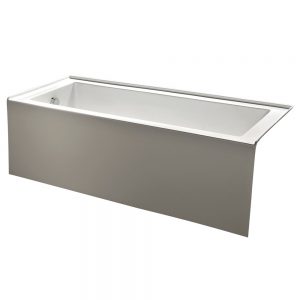
Kingston Brass VTDE603122L contemporary bathtub is my favorite alcove bathtub. Some of its features are:
- Material: Acrylic
- Dimensions: 60 x 30.69 x 22.06 inches
- Style: left-hand drain
- Shape: rectangle
- Water depth: 14 inches
- Capacity: 63.5 gallons
- Weight: weight: 95 pounds
2. Freestanding Bathtubs
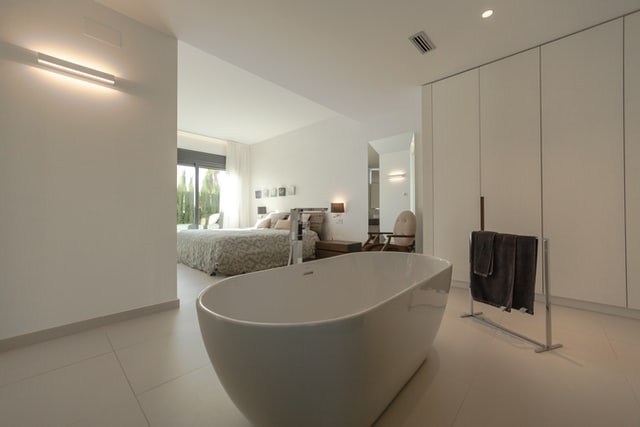
Freestanding bathtubs are bathtubs that are installed away from the bathroom walls. They require a big bathroom that they are accessible from all directions but can also be installed next to a wall if you have a small bathroom.
One question I am often asked is “How does a freestanding bathtub drain”? The fact of the matter is that a freestanding bathtub drains just like an alcove bathtub.
A trap and drainpipe are usually installed and concealed in the bathroom floor. If you are installing a freestanding bathtub for the first time, you will need to first install the plumbing before installing the tub. Some freestanding tubs have concealed plumbing while some have exposed plumbing.
So, what are the pros and cons of freestanding bathtubs? Let us starts with the pros.
Pros
- They are stylish. Freestanding bathtub are so beautiful and elegant. They are designed to be installed at the center of your bathroom which makes them really stand out especially if they are nicely polished. Most freestanding bathtubs are usually white in color which is such a glowing color and matches most bathroom walls. You can however also buy a freestanding tub in any other color you like in accordance with your bathroom décor and style.
- Contrasting faucets. To contrast the single tub color, freestanding bathtubs have polished metal (brass, bronze or chrome) faucets on one side. This greatly enhances the look of the tub, something you can’t always do with other types of tubs.
- Versatile – Unlike an alcove or other types of bathtubs, a freestanding bathtub can be installed at the center of the bathtub, nearer to the wall or in any direction you want as long as there is space.
- Improves your home value – You will most likely not install a freestanding bathtub in order to sell your house but should you decide to, you are sure to get more money as your home value will definitely increase. Landlords who install freestanding bathtubs will also ask for more in rent than those with alcove tubs.
- Available in many shapes and sizes – Due to the fact that these tubs are installed independent of walls, they are designed in varying shapes and sizes. In short, there is something for everyone.
Cons
- They are expensive – Freestanding bathtubs especially those made of cast-iron or cultured stones are quite expensive. If you are looking for one which will not break your bank then acrylic is a good material to work with.
- Need big bathrooms – You need to have a big bathroom to install a freestanding tub. By design, these tubs are best when installed at the center of the bathroom. You can however have them next to a wall if you are pressed for space.
- No shelves/storages – Before soaking in a freestanding bathtub, you will need to first gather all your necessities (soap, shampoo, towel, conditioner etc.) and place them nearby. Failure to do that will have you walking across the bathroom dripping water everywhere to grab a towel.
- Takes time to clean – Cleaning a freestanding bathtub is quite some work. Unlike an alcove bathtub where you only clean the inside and the front, with a freestanding tab you will have to clean the inside and all around it.
- Hard/expensive to install – what makes freestanding tubs hard and expensive to install is the installation of the extra plumbing coupled with their weight. Freestanding tubs are quite heavy and will definitely need a few people to lift during installation.
Best Freestanding Bathtub
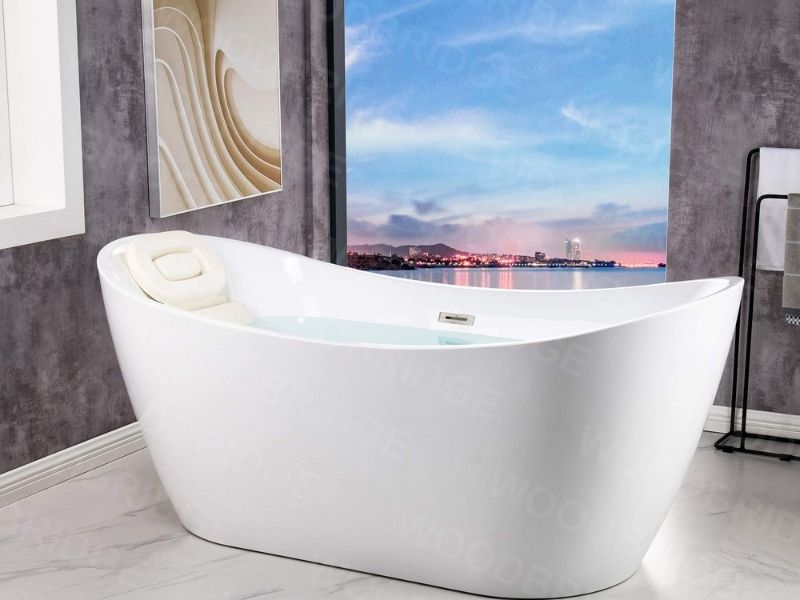
This Woodbridge freestanding bathtub is one of the best freestanding tubs in the market. Here are some of its features:
- Length: 59/67/71 inches
- Depth: 32 inches
- Height: 23 inches
- Material: Acrylic
- Style: oval
- Capacity: 60 gallons
3. Clawfoot Bathtubs

If you love vintage décor then a clawfoot bathtub will be worth your while. They are a special type of a freestanding bathtubs that have four feet (one in each corner) which are made of a heavy metal and shaped like claws, and hence the name clawfoot tubs.
Clawfoot tubs are stylish and can be designed to appear either contemporary or vintage, and sometimes a mix of the 2. If you really want to have a complete vintage look I would suggest you get a copper clawfoot tub but if you want to blend the 2 you can buy one made of acrylic or cast iron with brushed nickel/bronze/chrome feet.
There are 2 types of clawfoot tubs in as far as design is concerned. Some tubs have a smooth and flat/straight tops while some have a slipper design, which allows you to slant backwards while bathing. You can opt for a single slipper or a double slipper clawfoot tub.
Single slipper bathtubs are usually shorter in length and have their drains at the far end where your feet rests. Double slipper tubs on the other hand are ideal for 2 bathers and mostly have a center drain.
Due to their raised profile, clawfoot tubs plumbing is quite visible. While some people work hard to conceal it, some just buy high quality faucets and drains, which tend to compliment the overall tub design. Oil rubbed bronze, brushed nickel or chrome are perfect materials.
Let us look at the pros and cons of clawfoot bathtubs, starting with the pros.
Pros
- Vintage look – Clawfoot tubs are some of the oldest types of bathtubs. Having one in your house is akin to owning a piece of history. Copper clawfoot tubs are some my favorite clawfoot tubs but are quite pricey.
- They are Stylish – Just like contemporary freestanding bathtubs, clawfoot tubs are quite stylish. A white finished acrylic/cast-iron bathtub with contrasting bronze oil rubbed bronze feet for instance really stands out in a room.
- Versatility – Another thing to love about clawfoot tubs is that they can be installed anywhere in the bathroom as long there is space. Although best installed in the middle of the bathroom, you can install it just about anywhere you want. You also can select different designs as well as feet material to choose your preference.
- Perfect for uneven floor – Clawfoot tubs are designed in such a way that their feet can be adjusted so that the tub levels up in an uneven floor. Such is not possible with other types of tubs and you need to fix your floor first.
The Cons
- Price prohibitive – You may fall in love with these tubs but their prices may prevent you from owning one. Clawfoot tubs costs over a thousand dollars while those made of solid metal like copper costs even more.
- Exposed plumbing – Due to their design, these tubs have exposed plumbing. While these might not be an issue for some people, there are those who will be bothered by it.
- Needs a big bathroom – To install a clawfoot bathroom you will need to have a big bathroom, to access it from all the sides. You can also install it in a smaller bathroom but you will not reap its full benefits as someone with a big space.
- Extra cost – With a clawfoot bathtub, you will need to buy faucets (which often match the color and material of the feet) which is separate from the tub’s cost. These faucets are not cheap. Another thing you will have to buy is the drainage accessories.
- Quite heavy – Clawfoot tubs are quite heavy and therefore harder and expensive to install. A tub made of pure copper will need several people to lift.
Best Clawfoot Bathtub
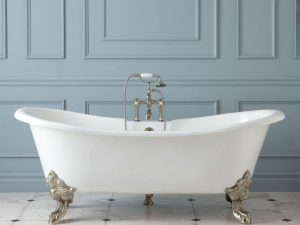
This Signature Hardware Clawfoot tub is one of the best in the market today. Here are some of its features:
- Materials: cast-iron
- Tub dimensions: 59″ L x 30-1/2″ W x 26-1/2″ H
- Drain placement: offset
- Interior: white porcelain enamel
- Built-in adjusters
- Monarch imperial feet
- water depth: 13 inches
4. Soaking/Japanese Bathtubs
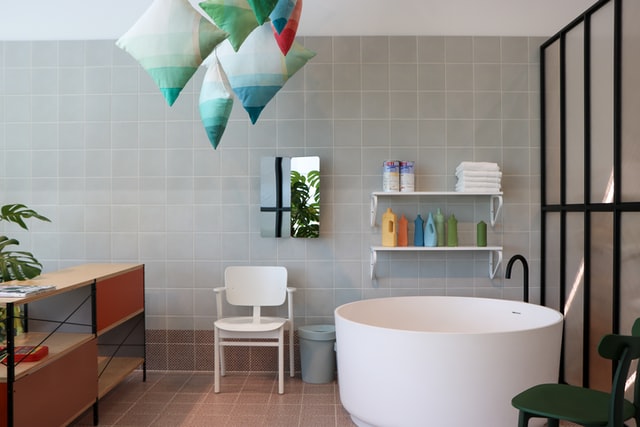
Soaking tubs are a special type of freestanding bathtubs that originated from Japan and that is why there are also known as Japanese tubs. The difference between contemporary western freestanding tubs and soaking tubs is that soaking tubs are quite taller and are used for soaking rather than bathing.
With a soaking tub, you usually bathe in the shower and later use the tub to soak yourself. These tubs come with a built-in seat (or a stool maybe used) and then water is filled all the way to the neck level. They are fantastic for relaxing as the water covers the entire body and you can also add any herbs you may want.
Japanese soaking tubs are usually round in shape while western-style soaking tubs are mostly oval. You can get a cheaper one made of acrylic for about 3000 dollars while high-end cultured stone or wooden soaking tubs go for as much as 40000 dollars.
Soaking tubs have many advantages. Let us look at some of them.
Pros
- Total relaxation – Soaking tubs are designed to offer whole body relaxation. Unlike other types of tubs where a big part of your body is not covered with water, these tubs are make sure that only your head is above the water.
- They are artistic – Tall and round/oval tubs are uncommon. Whichever design you go for you will surely fall in love with it. By nature, Japanese are very artistic. Don’t forget they are the ones who brought us bidet seats.
- Conserve space – Japanese soaking tubs don’t take up much bathroom space. Since the user’s legs are usually not stretched out, they are a fantastic choice if you need to soak up properly and still save bathroom space.
Cons
- They are expensive – A cheap soaking tub will start from about 2000-3000 dollars. Not many people can therefore afford them.
- Not readily available – You cannot always find one in a home improvement store.
- Not favorable for use by children, seniors and people with limited mobility as they are quite tall.
Best Japanese Soaking Tub
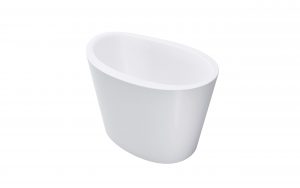
Aquatica True Ofuro Freestanding Stone Japanese Soaking Bathtub is a fantastic choice for a soaking tub. It is available in 3 different sizes including a mini size for folks with small bathrooms. Here are some of its features:
- Dimensions: 51.5 x 36.25 x 33.75 inches
- Material: Cultured stones
- Weight: 287 pounds
- Ergonomic back and neck rest
- Water depth: 24.25 inches
- Warranty: 25-year limited warranty
5. Walk-In Bathtubs
For the seniors/elderly or generally people with limited mobility, using a bathtub is almost impossible as they can’t climb into or out of one. Walk-in tubs are therefore designed in favor of these people.
A walk-in tub has a door that allows the use to simply walk inside the bathtub. These doors are usually watertight and once shut water cannot leak to the outside.
On one side of a walk-in tub is a built-in bench at a chair level, so that the user does not have to squat or sit at the bottom of the tub. To make sure that the use is safe, they also feature grab bars to aid in extra support and also prevent slipping.
For added relaxation and pain relief/massage, most walk-in tubs are also jetted. These means that hot water and air bubbles are released from these jets, offering a relaxing massage sensation that is perfect for muscle relaxation. In short, walk-in tubs are a combination of soaking and jetted tubs.
Contrary to what you might think, walk-in tubs do not take up too much bathroom space. They are actually not different from other types of tubs in terms of size. They are however a little wide than alcove tubs.
Pros
- Excellent for seniors – Without these types of tubs most seniors and other people with limited mobility would never enjoy the benefits of a bathtub.
- Two-in-one tubs – As we have seen, most walk-in tubs are used a soaking tubs as well as jetted tubs.
Cons
- Quite pricey – Walk-in tubs costs thousands of dollars. Unlike other types of types where you can get a cheaper tub, these tubs are usually made for a specific group of people and hence quality and safety can never be compromised. This makes them very expensive.
Best Walk-In Tub
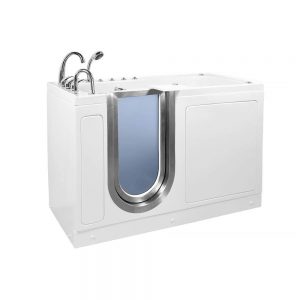
The Ella Companion massage walk-in tub is a decent choice to with. Here are some of its features:
- Material: acrylic
- Dimensions: 60 x 30 x 42 inches
- Style: Air and hydro
- Weight: 220 pounds
- 15-jet air massage
- In-line water heater
6. Corner Bathtubs

Corner tubs as their names suggests are usually installed on one of the bathroom’s corners. While most corner bathtubs are triangular in shape, there are some which are rectangular.
Most people install corner tubs to save on bathroom space while some others do it solely to enhance its design and style. For the latter, you will find that their corner tubs are massive in size and often feature other features such as soaking, whirlpool and can also be undermount or dropped-in.
Due to the above, corner tubs can either be cheap or very expensive. Undermount whirlpool corner tubs with a wooden deck for instance are quite expensive, and costs just as much to install.
Pros
- They stand out – High-end corners tubs are stylish and rare, and if you have one in your bathroom you definitely have good taste.
- Save space – if you are squeezed for space in your bathroom, or if your bathroom is designed in way that favors a corner tub then by all means go for one.
Cons
- They are not readily available – Unlike alcove or freestanding tubs, corner bathtubs are not available in every home improvement store.
Best Corner Bathtub
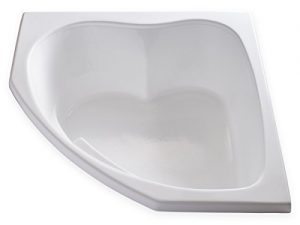
The Carver Tubs – SKC5555-Drop In Corner Two Person Soaking Bathtub is one of the best corner bathtubs. It is available in several styles so you can choose the one that bests fits your preference. Its features include:
- Dimensions: 18.5 x 55 x 55 inches
- Material: acrylic
- 125 pounds
- 2-pearson tub
7. Whirlpool/Jetted Tubs

When most people think of a jetted/whirlpool tub, they think of a Jacuzzi. There are actually people who call all jetted tubs Jacuzzis. The fact of the matter however is that Jacuzzi is a company that makes whirlpool tubs.
Whirlpool/jetted tubs are in my opinion the best tubs you can buy if you want to take relaxation to the next level. They offer a spa-like treatment from the comfort of your house.
As their names suggests, jetted tubs use jets of air-infused hot water at varying intensity and from different parts of the tub to hit your body to provide a massaging sensation. The bubbling effect of the air in the water is what creates whirlpools inside the bathtub and hence the term whirlpool tubs.
These tubs are usually a combination of many bathtubs. They include:
- Corner whirlpool tubs
- Freestanding whirlpool tubs
- Soaking jetted tubs
- Drop-in whirlpool tubs
There is everything to like and not much to not like about jetted tubs. If you have the resources to buy one then by all means go for it.
Best Whirlpool Tub
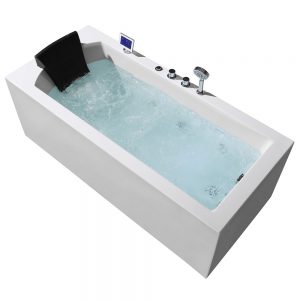
ARIEL Platinum PW1545930LW1 Whirlpool Bathtub is a fantastic tub. Some of its features include:
- Dimensions: 59 x 29.5 x 24.6 inches
- Material: acrylic
- Finish: chrome
- Built-in chemotherapy lighting
- Ergonomic headrest
8. Drop-In Bathtubs
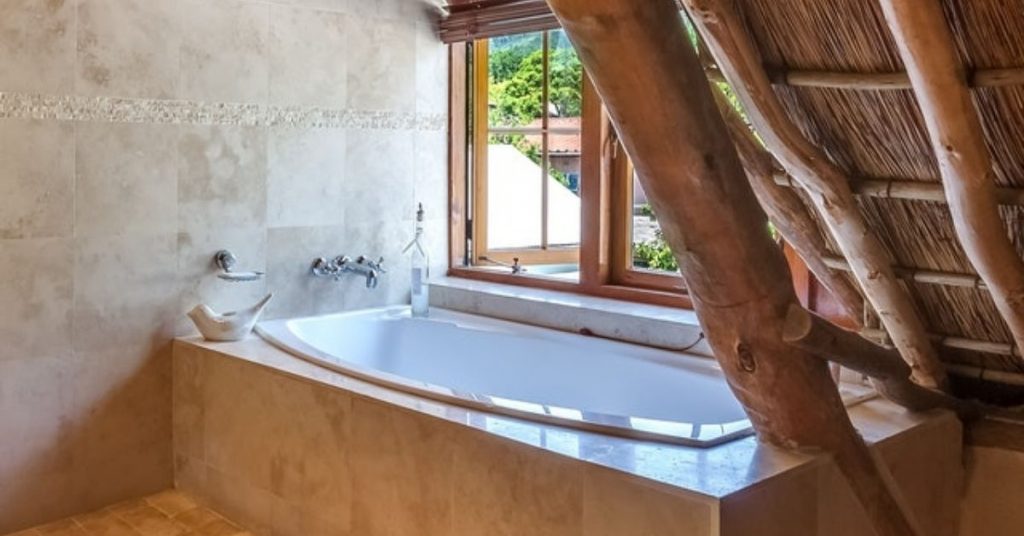
Drop-in tubs are a luxurious type of bathtub that are usually installed inside a raised platform/deck mostly in the middle of the bathroom. These tubs are usually designed with a wider rim which is installed flush with the deck.
They are known as drop-in tubs since you have to drop inside the bathtub from the deck. Often, this tubs are also jetted and can also double up as soaking tubs. Corner drop-in tubs are a good option for folks who do not have a big bathroom, or those who want a different style.
While you can use tile to build the tub’s deck, wood is also another great option although pricey. Whatever option you decide to go with, drop-in tubs are a great addition to your bathroom and most of them are big enough to be used by 2 people.
Apart from their high cost (especially installation cost) and the need for a bigger space, I cannot think of any other disadvantage of owning a drop-in tub.
Best Drop-In Bathtub
Kohler K-1184-0 Devonshire Drop-In Bathtub is a decent pick and not so expensive. Its features are:
- Dimensions: 62.63 x 34.38 x 22 inches
- Material: acrylic
- weight: 73 pounds
- Capacity: 60 gallons
- 1 year limited warranty
9. Undermount Tubs
Undermount tubs are very similar to drop-in tubs, the only difference being that undermount bathtub’s rim are covered unlike drop-in tub’s which are usually flush with the platform/deck. You would normally use stone like marbles or tiles to cover the rim.
To go with an undermount tub or drop-in one solely depends on the preference of the buyer/homeowner. One advantage of installing an undermount tub is that there is not the rim which may interrupt the design of the deck and therefore allows you to customize the deck as you may wish.
10. Hot Tubs
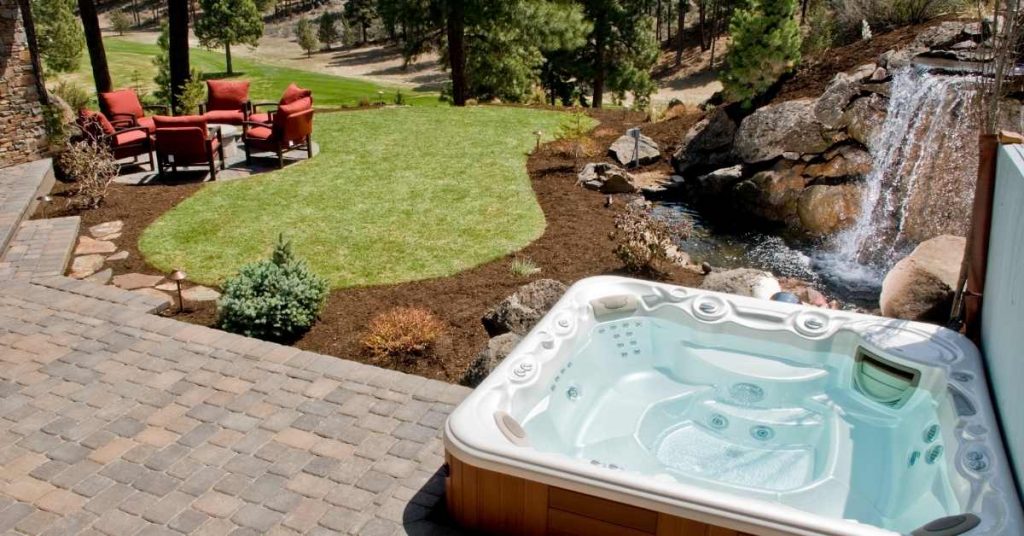
Hot tubs are outdoor bathtubs that are designed to be used by 2 or more people. While hot tubs can also be installed indoors, they are primarily used outside the house usually by about 5 people.
Hot tubs are often confused with in-ground spas and whirlpool/jetted tubs. So, what is the difference hot tubs and jetted tubs. The main difference between hot tubs and jetted tubs is that hot tubs are portable and are mostly used outdoors.
Jetted tubs on the other hand are installed inside the bathroom and are hence not portable. Another difference is that hot tubs can be used by more than 2 people while jetted tubs can only be used by 1 or 2 people only.
The difference between hot tubs and spas is that spas are permanently built into the ground (usually next to a pool) and have fewer features as a hot tub, takes longer to heat up and have no covers.
Often refer to all jetted tubs, hot tubs and spas as Jacuzzis. The fact of the matter however is that Jacuzzi is a registered trademark and was the first company to make hot tubs. There are lots of hot tubs and whirlpool/jetted tubs that are not necessarily made by Jacuzzi the company.
Best Hot Tub
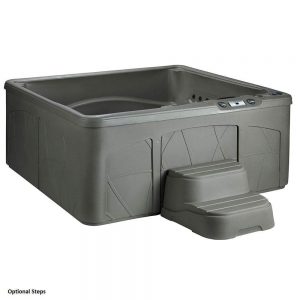
The LifeSmart LS350DX 5 Person Outdoor Patio Hot Tub is one of the best in the market. Let us look at some of its features:
- 5-person hot tub
- 28 jets
- Cover
- Bottom drain
- Material: Molded polyethylene
- Temperature: 80-104 Fahrenheit
- Pump: 2.5 hp
- LED light
- Steps included
- Water capacity: 325 gallons
Bathtub Materials
The other thing that you really need to pay attention to while buying a bathtub is the material the bathtub is made from. Needless, to say, there are cheaper and expensive materials. This is why some tubs are more durable than others.
The following are the different types of bathroom materials:
1. Fiberglass Bathtubs
Fiberglass bathtubs are usually the most affordable types of bathtubs. To make a fiberglass bathtub, the fiberglass is molded into the desired shape and size and then coated with a gelcoat resin.
Fiberglass bathtubs don’t last long and will flex/warp after sometime. They also have a poor heat retention hence you can’t soak up in the tub for long. High hygiene levels are needed since these tubs are porous (absorbs water) allowing mold/mildew to thrive easily.
If you are looking to flip your house or are looking to install tubs in rental properties then fiberglass bathtubs will work well for you since they are inexpensive. They are also lightweight and hence easy to install.
2. Acrylic Bathtubs
Most bathtubs in the market are made of acrylic. These type of bathtubs are not so expensive, but neither are they cheap or of inferior quality. They are perfect choice for most middle-class citizens.
Acrylic bathtubs are made by bending and molding an acrylic sheet into the desired shape and size and then reinforcing it with fiberglass. These tubs are therefore quite strong and lightweight at the same time.
I like the fact that acrylic tubs are excellent at retaining heat, resists chipping and cracking, something that cannot be said of fiberglass tubs. They are also easier to clean and are available in a variety of texture, colors and shapes.
Acrylic tubs will however flex, fade or scratch after years of usage although not to the tune of fiberglass tubs. They are usually more expensive than fiberglass tubs though.
3. Cast-Iron Bathtubs
Cast-iron is a heavy and expensive material, and so are bathtubs made of cast-iron. They were first sold by John Michael Kohler, the founder of Kohler. The cast-iron of those days is however not as good as the cast iron used today (low-lead) but not that bad either.
To make a cast-iron bathtub, molten iron is poured into a mold of the desired shape and size, smoothed, and later coated with enamel. Cast-iron tubs are durable, resistant to chipping and scratching and also very easy to clean.
Due to their weight, cast-iron tubs needs to be installed in a house with a strong floor. If you suspect yours might not hold up then you should reinforce it first, or buy a lightweight tub.
4. Copper Bathtubs
Copper is an even more expensive material than cast-iron. Copper bathtubs usually have a vintage look to them and are a favorite for folks looking to have a antique/rustic décor in their in their bathroom.
A copper bathtub is usually a handmade item more than a manufactured one. Thick layers of copper are hammered and then curved to the desired shape and size, and later smoothened off to end with the perfect copper tub.
These tubs are usually quite pricey and heavy. Again, you will need to have a strong floor to install a copper bathtub. Sinkology Clawfoot copper bathtub is one of the best copper tubs in the market. Check it out below.
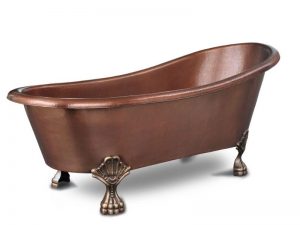
5. Cultured Stones Bathtubs
These types of tubs are not very common and are quite expensive. To make such a tub, little chunks of stones are crushed in a machine and then mixed with a resin for added strength and durability. They are then molded into the desired shape and size.
To finish off these tubs, a smooth layer of gelcoat is added. As you can imagine, the raw materials, process and time used to make these tubs makes them quite price inhibitive and not many folks can afford such.
Once installed, these tubs are so beautiful while at the same time low maintenance. They are non-porous hence mold cannot thrive and will also not chip. Scratches are easy to buff off too.
6. Wooden Bathtubs

Wooden tubs are handmade and therefore quite expensive. Some of them cost as much as 40000 dollars. On its own, wood is an expensive material but the process also takes a long time and also need very skilled woodworkers, who also charge top dollar for their craft.
Western Cedar is among the favorite wood for a tub owing to its grain beauty, and also lasts longer than other types of wood. Wooden tubs are excellent at retaining heat hence your bath water remains hot for a long time.
These tubs requires care to prevent the wood from shrinking or even rotting. You will not readily find these tubs in your local home improvement store.






